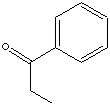| PROPIOPHENONE
|
||||||||||||||||||||||||||||||||||||||||||||||||||||||||
|
PRODUCT IDENTIFICATION |
||||||||||||||||||||||||||||||||||||||||||||||||||||||||
| CAS NO. | 93-55-0 |
|
||||||||||||||||||||||||||||||||||||||||||||||||||||||
| EINECS NO. | 202-257-6 | |||||||||||||||||||||||||||||||||||||||||||||||||||||||
| FORMULA | C6H5COC2H5 | |||||||||||||||||||||||||||||||||||||||||||||||||||||||
| MOL WT. | 134.18 | |||||||||||||||||||||||||||||||||||||||||||||||||||||||
| H.S. CODE | 2914.39 | |||||||||||||||||||||||||||||||||||||||||||||||||||||||
|
TOXICITY |
||||||||||||||||||||||||||||||||||||||||||||||||||||||||
| SYNONYMS | Ethyl phenyl ketone; | |||||||||||||||||||||||||||||||||||||||||||||||||||||||
| 1-Phenyl-1-propanone; Phenyl ethyl ketone; Propionylbenzene; | ||||||||||||||||||||||||||||||||||||||||||||||||||||||||
|
SMILES |
||||||||||||||||||||||||||||||||||||||||||||||||||||||||
|
CLASSIFICATION |
|
|||||||||||||||||||||||||||||||||||||||||||||||||||||||
|
PHYSICAL AND CHEMICAL PROPERTIES |
||||||||||||||||||||||||||||||||||||||||||||||||||||||||
| PHYSICAL STATE | clear to pale yellow liquid | |||||||||||||||||||||||||||||||||||||||||||||||||||||||
| MELTING POINT |
16 - 18 C |
|||||||||||||||||||||||||||||||||||||||||||||||||||||||
| BOILING POINT | 214 - 218 | |||||||||||||||||||||||||||||||||||||||||||||||||||||||
| SPECIFIC GRAVITY | 1.01 | |||||||||||||||||||||||||||||||||||||||||||||||||||||||
| SOLUBILITY IN WATER | Insoluble | |||||||||||||||||||||||||||||||||||||||||||||||||||||||
| pH |
|
|||||||||||||||||||||||||||||||||||||||||||||||||||||||
| VAPOR DENSITY | ||||||||||||||||||||||||||||||||||||||||||||||||||||||||
|
AUTOIGNITION |
||||||||||||||||||||||||||||||||||||||||||||||||||||||||
|
NFPA RATINGS |
Health: 2; Flammability: 1; Reactivity: 0 | |||||||||||||||||||||||||||||||||||||||||||||||||||||||
|
REFRACTIVE INDEX |
||||||||||||||||||||||||||||||||||||||||||||||||||||||||
| FLASH POINT |
85 C |
|||||||||||||||||||||||||||||||||||||||||||||||||||||||
| STABILITY | Stable under ordinary conditions | |||||||||||||||||||||||||||||||||||||||||||||||||||||||
|
GENERAL DESCRIPTION & APPLICATIONS |
||||||||||||||||||||||||||||||||||||||||||||||||||||||||
Phenylethyl is a structural skeleton found in sympathomimetic amines that
have important physiological functions within the body as neurotransmitters in
the central nervous system and hormones in the blood circulation. Phenyl ketone
structure is found in keto alkaloids such as cathinone, a contributor of
stimulant effect. Phenyl ketone is a fuel in the brain.
Propiophenone (Phenyl ethyl ketone) is a useful intermediate to prepare nervous system drugs (anxiolytic and hypnotic drugs). Bupropion is an example which has propiophenone moiety. Bupropion is an aminoketone class antidepressant. Propiophenone is used in the synthesis of ketoamphetamines such as cathinone and methcathinone. Propiophenone can also be converted to synthetic aryl alkenes such as cinnamic acids. some propiophenone derivatives such as paroxypropione (4-hydroxypropiophenone) is a drug called adrenergic beta-antagonist which bind to but do not activate beta-adrenergic receptors thereby blocking the actions of beta-adrenergic agonists. Adrenergic beta-antagonists are used for treatment of hypertension, cardiac arrhythmias, angina pectoris, glaucoma, migraine headaches, and anxiety. Propiophenone is a constituent of synthetic perfumes, flavouring agents, and of paints to stabilize other ingredients. Ketones can be made by the oxidation of secondary alcohols and the destructive distillation of certain salts of organic acids. In addition to as polar solvents, ketones are important intermediates in the syntheses of organic compounds such as alkoxides, hydroxyalkynes, imines, alcohols (primary, secondary as well as tertiary), acetals, thioacetals, phosphine oxides, geminal diols, hydrazones, organic sulfite and cyanohydrins. Propiophenone is a clear liquid that is insoluble in water, but miscible with methanol, ethanol, diethyl ether, benzene and toluene. Butyrophenone is the basic structure of antipsychotic drugs such as droperidol, azaperone, trifluperidol, bromperidol, and haloperidol. Chemical structure of Neuroleptic agents are diverse; including phenothiazines, thioxanthenes, butyrophenones, dibenzoxazepines, dibenzodiazepines, dihydroindolones, and diphenylbutylpiperidines. Antipsychotic agents control agitated psychotic behavior, alleviate acute psychotic states, reduce psychotic symptoms, and exert a quieting effect. They are used in schizophrenia, senile dementia, transient psychosis following surgery or myocardial infarction, etc. These drugs are often referred to as neuroleptics alluding to the tendency to produce neurological side effects, but not all antipsychotics are likely to produce such effects. Many of these drugs may also be effective against nausea, emesis, and pruritus. Some vermicides have hydroxy or methoxy butyrophenone (Desaspidin).Members of aryl ketone
|
||||||||||||||||||||||||||||||||||||||||||||||||||||||||
| SALES SPECIFICATION | ||||||||||||||||||||||||||||||||||||||||||||||||||||||||
|
APPEARANCE |
clear to pale yellow liquid | |||||||||||||||||||||||||||||||||||||||||||||||||||||||
| PURITY |
98.0% min |
|||||||||||||||||||||||||||||||||||||||||||||||||||||||
| MELTING POINT |
16 - 18 C |
|||||||||||||||||||||||||||||||||||||||||||||||||||||||
| WATER |
0.5% max |
|||||||||||||||||||||||||||||||||||||||||||||||||||||||
| TRANSPORTATION | ||||||||||||||||||||||||||||||||||||||||||||||||||||||||
| PACKING | 200kgs in Drum | |||||||||||||||||||||||||||||||||||||||||||||||||||||||
| HAZARD CLASS | ||||||||||||||||||||||||||||||||||||||||||||||||||||||||
| UN NO. | ||||||||||||||||||||||||||||||||||||||||||||||||||||||||
| OTHER INFORMATION | ||||||||||||||||||||||||||||||||||||||||||||||||||||||||
| Hazard Symbols: XN, Risk Phrases: 22-36, Safety Phrases:
26
|
||||||||||||||||||||||||||||||||||||||||||||||||||||||||
